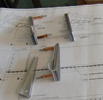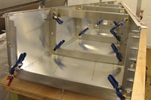


random user submitted photo
CG Envelope
2 posts
• Page 1 of 1
CG Envelope
How does one go about creating a CG envelope similar to something like this?
Bill Volcko XNS0068
Xenos A N68WV 99% flush rivets
Aerovee and Prince P-Tip
MGL Discovery Lite w/ Sandia STX 165R
V6
First hole 4/1/16
First flight 8/24/18
Phase I complete...finally!!!
Also flying a Challenger II since 1999
Xenos A N68WV 99% flush rivets
Aerovee and Prince P-Tip
MGL Discovery Lite w/ Sandia STX 165R
V6
First hole 4/1/16
First flight 8/24/18
Phase I complete...finally!!!
Also flying a Challenger II since 1999
-

bvolcko38 - Posts: 282
- Joined: Fri Feb 19, 2016 7:40 am
- Location: Finger Lakes
Re: CG Envelope
Bill,
The chart you attached may not be all that useful for our planes because of the way the chart is constructed. Specifically, the horizontal axis on the example chart is in moments, and "moments" isn't really what we care about in a W&B calculation (it's really about CG position relative to the wing chord). I'd suggest that you build a W&B chart like what Sonex uses in their Flight Manual where the horizontal axis is in "% MAC" or "Inches aft of datum" (see attached scan from the manual).
If you want to generate a chart like the one you included, you'll need to map out the corner points of the allowable area. Do this one corner at a time. It would go like this:
Bottom Left: Lowest acceptable (or anticipated) weight = aircraft empty weight + min pilot wt + min fuel wt (something like 675 + 100 + 25 = 800 lbs). You'll have to calculate the moment for this condition using your particular W&B data, but it will be something like 51,835 in-lbs [43,000 in-lbs empty aircraft moment + (100 lbs pilot x 76.9 inches) + (25 lbs fuel x 45.8 inches)]. Plot this point on your graph.
Top Left: highest allowable weight (gross weight), and the moment will be calculated using the scenario of getting to gross weight by placing as much weight as far forward as possible. This would look like full fuel, no baggage, and as much pilot weight (collectively I'll just call the combined weight of all occupants as "pilot" weight) as it takes to get to gross weight. For example, using 1150 lbs gross weight, pilot weight would be 375 lbs (1150 lbs gross - 675 lbs airplane - 100 lbs fuel = 375 lbs). The moment for this would then be 76,412 in-lbs [43,000 in-lbs empty aircraft moment + (375 lbs pilot x 76.9 inches) + (100 lbs fuel x 45.8 inches)].
In the same way, you'll calculate the weight and moment for the remaining corner points using the conditions that define those points. They would look like this:
Top Right: gross weight, & moment calculated by multiplying the aft cg limit by the gross weight (for example, 70.3 inches aft limit * 1150 lbs = 80,845 in-lbs).
Bottom Right: min acceptable weight, & moment from max weight placed aft (aircraft empty weight, min fuel, min pilot weight, max baggage). For example, 55,915 in-lbs [43,000 in-lbs empty aircraft moment + (100 lbs pilot x 76.9 inches) + (25 lbs fuel x 45.8 inches) + (40 lbs baggage x 102.0 inches)]. Of course, you'll have to use your own min pilot weight, min fuel, and arm distances that actually exist in your plane.
The left middle point is really just the top corner of the aerobatic limit box, so you calculate it just like before. Same for the right middle point.
You'll have to play with all these loading situations, calculate the weights and moments, them plot them on the chart. You can do this on graph paper, or plug everything into excel and have it graph the results for you. That part is pretty straightforward if you're familiar with spreadsheets, but the real effort comes from thinking through the loading situations that define each of the critical points of the chart.
Jeff
The chart you attached may not be all that useful for our planes because of the way the chart is constructed. Specifically, the horizontal axis on the example chart is in moments, and "moments" isn't really what we care about in a W&B calculation (it's really about CG position relative to the wing chord). I'd suggest that you build a W&B chart like what Sonex uses in their Flight Manual where the horizontal axis is in "% MAC" or "Inches aft of datum" (see attached scan from the manual).
If you want to generate a chart like the one you included, you'll need to map out the corner points of the allowable area. Do this one corner at a time. It would go like this:
Bottom Left: Lowest acceptable (or anticipated) weight = aircraft empty weight + min pilot wt + min fuel wt (something like 675 + 100 + 25 = 800 lbs). You'll have to calculate the moment for this condition using your particular W&B data, but it will be something like 51,835 in-lbs [43,000 in-lbs empty aircraft moment + (100 lbs pilot x 76.9 inches) + (25 lbs fuel x 45.8 inches)]. Plot this point on your graph.
Top Left: highest allowable weight (gross weight), and the moment will be calculated using the scenario of getting to gross weight by placing as much weight as far forward as possible. This would look like full fuel, no baggage, and as much pilot weight (collectively I'll just call the combined weight of all occupants as "pilot" weight) as it takes to get to gross weight. For example, using 1150 lbs gross weight, pilot weight would be 375 lbs (1150 lbs gross - 675 lbs airplane - 100 lbs fuel = 375 lbs). The moment for this would then be 76,412 in-lbs [43,000 in-lbs empty aircraft moment + (375 lbs pilot x 76.9 inches) + (100 lbs fuel x 45.8 inches)].
In the same way, you'll calculate the weight and moment for the remaining corner points using the conditions that define those points. They would look like this:
Top Right: gross weight, & moment calculated by multiplying the aft cg limit by the gross weight (for example, 70.3 inches aft limit * 1150 lbs = 80,845 in-lbs).
Bottom Right: min acceptable weight, & moment from max weight placed aft (aircraft empty weight, min fuel, min pilot weight, max baggage). For example, 55,915 in-lbs [43,000 in-lbs empty aircraft moment + (100 lbs pilot x 76.9 inches) + (25 lbs fuel x 45.8 inches) + (40 lbs baggage x 102.0 inches)]. Of course, you'll have to use your own min pilot weight, min fuel, and arm distances that actually exist in your plane.
The left middle point is really just the top corner of the aerobatic limit box, so you calculate it just like before. Same for the right middle point.
You'll have to play with all these loading situations, calculate the weights and moments, them plot them on the chart. You can do this on graph paper, or plug everything into excel and have it graph the results for you. That part is pretty straightforward if you're familiar with spreadsheets, but the real effort comes from thinking through the loading situations that define each of the critical points of the chart.
Jeff
- sonex1374
- Posts: 605
- Joined: Thu Mar 27, 2014 1:02 am
2 posts
• Page 1 of 1
Who is online
Users browsing this forum: Google [Bot] and 60 guests







